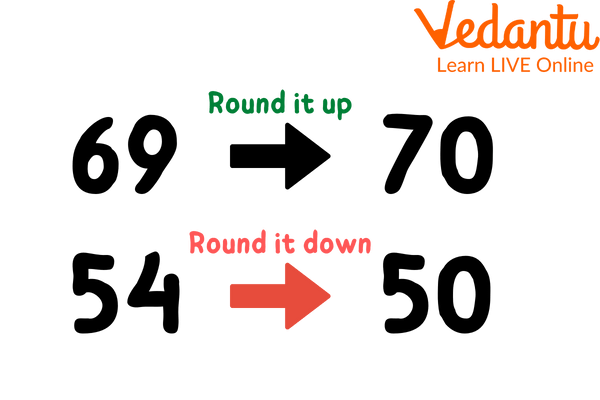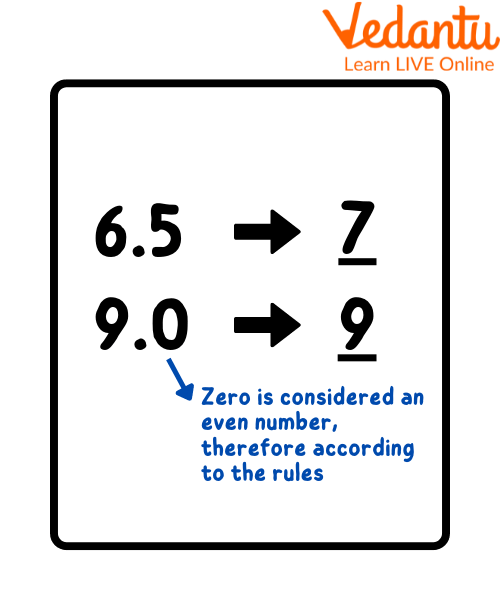




How to Round Numbers to the Nearest Hundred With Simple Tricks
Have you ever scored an 18.5 out of 20, but your teacher says well done, you have scored a good 19 out of 20, and you are left confused about how a teacher can mistakenly increase your score by 0.5? Actually, it is not a mistake, it is a technique called estimation or rounding off a number to simplify it.

Showing Rounding Off of a Number
Rounding off a number means estimating or changing the number to the one it is closest to. Rounding off is a technique used in various subjects like Physics, Chemistry, and Mathematics.
Rounding off implies a number is simplified by changing its worth nearer to the closest number. It may be applied well for any whole number, decimal at different spots of hundreds, tens, tenths, and so on. Rounding off a number is done to maintain the significant figures.
Significant Figures
A significant figure is the number of positional digits in a number that is reliable and necessary to indicate the necessary quantity or meaning.
The number 23.4 has a total of 3 significant figures. According to the rules, every non-zero digit in a number is always significant. 6.21388 has six significant digits (all the numbers counted as significant give useful information). Thus, 82 has two significant digits, and 82.6 has three significant digits.
How to Round off: Rounding off Rules
Rounding Rules for Whole Numbers
To answer the question of how to round off, there are a few simple steps to be always followed. Those are as follows:
Step 1: To obtain a precise end result, carefully pick the last place value.
Step 2: Search for the next smallest place, which is towards the right of the number that is being estimated. For instance, if you want to estimate a digit from a tens place, look for a digit at the one's place.
Step 3: If the digit succeeding the number to be rounded off is under 5, the digit remains unchanged. Any number of digits after that number is converted to zero, and this is called rounding down.
Step 4: If the digit succeeding the number to be rounded off is greater than 5, the digit is increased by 1 this is called rounding up.
Step 5: If the digit succeeding the digit to be rounded off is 5 or 5 followed by 0’s, then the figure to be rounded shall be
incremented by 1 if it is odd, and
unchanged if even. In this case, 0 is considered an even number.

Phenomenon of Rounding Up and Rounding Down a Number
For example, in the above image, 69 is rounding up, and 54 is rounding down by applying the rule discussed in step 5.
Rounding Rules for Decimal Numbers
Step 1: Look for the digit to be rounded and look at its preceding number.
Step 2: If the digits preceding the number to be rounded off are under 5, consider them equal to zero.
Step 3: If the digits preceding the number to be rounded off are greater than or equivalent to 5, then the number is increased by 1.

Rounding Off the Decimals
Rounding off to the Nearest 100
Let's take the example of the number 4850. To round off this number to its nearest hundreds of places and following are the steps:
Step 1: First, identify the digit present at the hundreds place: 8
Step 2: Then, identify the next smallest place in the number: 5
Step 3: As per the rules, if the smallest place digit is greater than or equivalent to 5, round up the digit. Therefore, add +1 to the digit at the hundreds place. 8+1=9. And the other digits become zero.
Answer: So the final number is 4900.
Solved Examples
Q 1. Round off 1647 to the nearest hundreds.
Ans: The answer to the question will be 1700
Step 1: First, identify the digit present at the hundreds place: 6
Step 2: Then, identify the next smallest place in the number: 4
Step 3: As per the rules, if the digits preceding the no. to be rounded off are under 5, then consider them equal to zero. Therefore, the digit at the hundreds place remains the same. And the other digits become zero. So the final number is 1600.
Q 2. What is the nearest number after rounding off the following numbers to the nearest hundreds?
1863
4265
430
Ans: Let's round off the following one by one by using the rules of rounding off to a hundred
A. 1863
Step 1: First, identify the digit present at the hundreds place: 8
Step 2: Then, identify the next smallest place in the number: 6
Step 3: As per the rules, if the smallest place digit is greater than or equivalent to 5, round up the digit. Therefore, add +1 to the digit at the hundreds place. 8+1=9. And the other digits become zero. So the final number is 1900.
B. 4265
Step 1:First, identify the digit present at the hundreds place: 2
Step 2: Then, identify the next smallest place in the number: 6
Step 3: As per the rules, if the smallest place digit is greater than or equivalent to 5, then round up the digit. Therefore, add +1 to the digit at the hundreds place. 2+1=3. And the other digits become zero. So the final number is 4300.
C. 430
Step 1: First, identify the digit present at the hundreds place: 4
Step 2: Then, identify the next smallest place in the number: 3
Step 3: As per the rules, if the digit succeeding the number to be rounded off is under 5, the digit remains unchanged. Any number of digits after that number is converted to zero. So the final number is 400.
Q 3. Round the following numbers to the nearest hundred.
3,00,678
13,05,889
Ans:
1. 3,00,678 is the Given Number.
We can determine that the number's digit in the tens position is 7, which is greater than five. Therefore, add a 1 to the hundreds place, and add zeros in the units and tens of the number. Thus, 3,00,700 is the result of rounding 3,00,678 to the nearest hundred.
2. 13,05,889 is the Given Number.
We round to the nearest multiple of the hundred places bigger than the integer when the digit in the tens place is 8, which we see. 13, 05, 889 is closer to 13, 05, 900 than 13, 05, 800.
Practice Questions
Q 1. Round off 5672.8 to the nearest 100.
Ans: 5700
Q 2. Round of 5681 to the nearest hundreds.
Ans: 5700
Q 3. What is the nearest number after rounding off the following to the nearest 100.
9832
441
Ans: a) 10000 b) 400
Summary
Keeping a number's value close to its original value while simplifying it is known as rounding. The outcome of rounding off is less precise but simpler, particularly when doing mathematical procedures. Similar to this, rounding a number to the closest hundred entails placing zeros in the units and tens and increasing or decreasing the remainder by one. In the areas of this website, students can find examples of solved problems, definitions, and round-off guidelines.
FAQs on Rounding Off to the Nearest 100 Made Easy
1. What does rounding off to the nearest 100 mean?
Rounding off to the nearest 100 means making a number simpler by changing it to the closest multiple of 100. This process helps in estimating values. For example, 247 rounded to the nearest 100 becomes 200 because it is closer to 200 than to 300.
2. How do you round a number to the nearest 100?
To round a number to the nearest 100, look at the digit in the tens place.
- If it is 5 or more, increase the hundreds digit by one.
- If it is 4 or less, keep the hundreds digit the same.
3. Why do we round numbers to the nearest 100?
We round numbers to the nearest 100 to make calculations easier and quicker. Rounding helps in summarizing large data and estimating results, which is useful when exact figures are not needed in math or daily life.
4. What is the rule for rounding off to the nearest 100?
The rule for rounding off to the nearest 100 is:
- If the tens digit is 5 or more, round up.
- If it is 4 or less, round down.
5. Can you show an example of rounding 673 to the nearest 100?
To round 673 to the nearest 100, look at the tens digit (7). Since 7 is more than 5, round up. So, 673 becomes 700 when rounding to the nearest 100.
6. What happens if the tens digit is exactly 5 when rounding to 100?
When the tens digit is exactly 5, you round up to the next hundred. For example, 250 becomes 300. This follows the basic rounding rule that 5 or more means going to the next higher place value.
7. How do you write a math equation for rounding a number to the nearest 100?
You can use this formula: $$\text{Nearest 100} = 100 \times \text{round}\left(\frac{\text{Number}}{100}\right)$$. Here, you divide the number by 100, round to the nearest whole number, then multiply by 100 to find the nearest hundred.
8. In what situations is rounding to the nearest 100 useful?
Rounding to the nearest 100 is helpful in situations like budgeting, estimating total costs, reporting population, or managing inventory. Rounding gives quick, easy-to-understand figures when exact numbers are not important for the calculation.
9. What is the difference between rounding to the nearest 10 and the nearest 100?
When rounding to the nearest 10, you look at the units digit, while for the nearest 100, check the tens digit. Rounding to 100 provides a broader estimate, which is less precise than rounding to the nearest 10.
10. Does rounding to the nearest 100 always increase a number?
Rounding to the nearest 100 does not always increase a number. Sometimes it decreases, depending on the tens digit. For example, 184 rounds down to 100, while 178 rounds up to 200. Whether it increases or decreases depends on which hundred is closer.
11. How do you round 2,456 to the nearest 100?
The tens digit in 2,456 is 5, so round up. 2,456 rounded to the nearest 100 is 2,500. Follow the basic rounding rule: if the tens digit is 5 or higher, move up to the next hundred.























